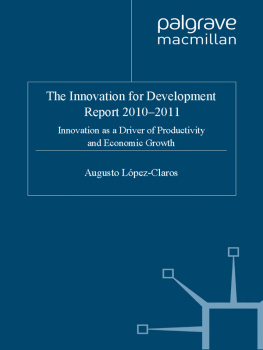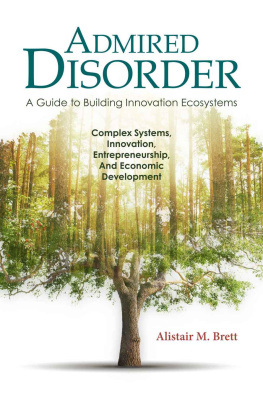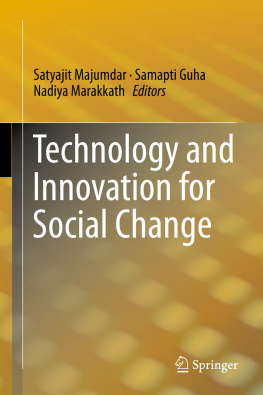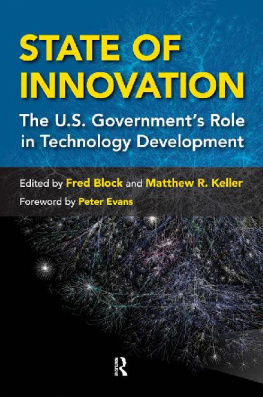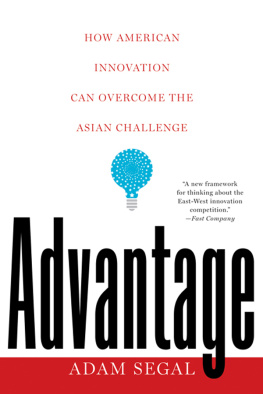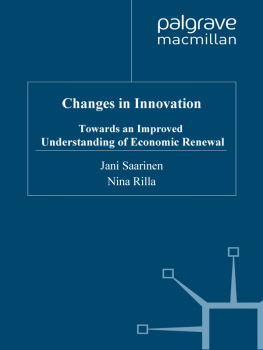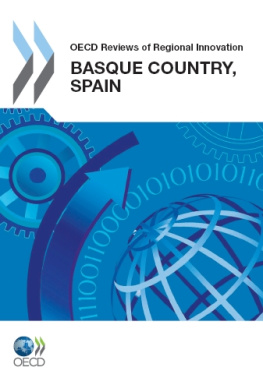
The Innovation for Development Report 20102011
Innovation as a Driver of Productivity and Economic Growth
Augusto Lpez-Claros, Editor
Honorary Professor, European Business School

The Innovation for Development Report 20102011: Innovation as a Driver of Productivity and Economic Growth
European Business School
Augusto Lpez-Claros
Editor
The terms country and nation as used in this report do not in all cases refer to a territorial entity that is a state as understood by international law and practice. The terms cover well-defined, geographically self-contained economic areas that may not be states, but for which statistical data are maintained on a separate and independent basis.

Copyright 2011
Augusto Lpez-Claros
All rights reserved. No reproduction, copy or transmission of this publication may be made without written permission.
No paragraph of this publication may be reproduced, copied or transmitted save with written permission or in accordance with the provisions of the Copyright, Designs and Patents Act 1988, or under the terms of any licence permitting limited copying issued by the Copyright Licensing Agency. Any person who does any unauthorized act in relation to this publication may be liable to criminal prosecution and civil claims for damages.
The authors have asserted their rights to be identified as the authors of this work in accordance with the Copyright, Designs and Patents Act 1988.
First published 2011 by
PALGRAVE MACMILLAN
Houndmills, Basingstoke, Hampshire RG21 6XS and
175 Fifth Avenue, New York, N.Y. 10010
PALGRAVE MACMILLAN is the global academic imprint of the Palgrave Macmillan division of St. Martins Press, LLC and of Palgrave Macmillan Ltd. Macmillan is a registered trademark in the United States, United Kingdom and other countries. Palgrave is a registered trademark in the European Union and other countries.
ISBN 9780230239678
This book is printed on paper suitable for recycling and made from fully managed and sustained forest sources.
A catalogue record for this book is available from the British Library. A catalogue record for this book is available from the Library of Congress.
10 9 8 7 6 5 4 3 2 1
20 19 18 17 16 15 14 13 12 11
Printed and bound in Great Britain by Hobbs the Printer, Totton, Hampshire.
Foreword
Steven A. Ballmer,
Chief Executive Officer,
Microsoft Corporation
Innovation is as important today as at any time in recent human history. Governments, businesses, NGOs, and individuals from nearly every country are facing challenges that will define the next decade. Climate change, economic dislocation, disease, and pandemics are just some of the issues that challenge our progress, causing leaders of communities, companies, and countries to pause and question: What can we do to respond to these perils? How can we put ourselves in a stronger position for the future? How can we hasten opportunities for development and growth without further compromising our shared planet?
The answers to these questions are complex. What we know is that we need a new formula for a new era of growth and development, a different approach from the one that has driven our progress in the past. To prepare for this future, we must not only solve the problems of today, but dare ourselves to think about what challenges we may face in the coming years and imagine how we can meet them.
This is where we must turn to innovation. As I travel the world, I hear from leaders who see innovation as offering the best opportunity to increase the quality of peoples lives and stimulate economic growth. Innovation will fuel a better, stronger, and more efficient global society.
Of course, innovation comes with many definitions, but at its core, I see innovation as imaginative and more affordable breakthroughs that allow individuals, companies, NGOs, governments, and whole societies to achieve something never before possible. By doing something in a new way, innovation is the game-changer that pushes us beyond the boundaries that were thought to exist and allows the world to continually advance.
This kind of innovation does not happen in a vacuum. It requires work across borders, sectors, and industries. While the private sector is often stronger in the development part of R&D, the public sector excels in the research that is the foundation for breakthroughs. Both sectors must work together and draw on their respective strengths. As we face an increasing number of shared global challenges, we must also share ideas more freely. This will ensure that both developed and developing nations can contribute to and benefit from human innovation.
We should also acknowledge that innovation will come from everywherenot just wealthy nations or so-called innovation industries like the pharmaceutical and IT sectors. I have no doubt that countries like China, India and Brazil will create some of the most revolutionary ideas and services over the next decade, driven by the dual needs to lower costs and broaden access for their vast populations. Individuals and virtual global communities will also increasingly use ubiquitous data and connectivity to make meaningful breakthroughs.
In my work at Microsoft, I have seen the rewards of innovation, not only for our company and customers, but also for communities and economies everywhere. Like many companies, Microsofts future relies on our ability to innovate. One-third of our companys global workforce is dedicated to research and development and, despite economic challenges in the recent past, we actually increased our spending on research in our 2010 fiscal year to US$9.5 billion. Why did we do this? Because history has shown that innovation is a reliable engine for growth. We truly believe that our long-term future depends on our ability to sustain a drumbeat of new ideas and innovative technologies that improve peoples lives. And of course we are not alone. Many other companies, governments, NGOs, and academic institutions are also investing in innovation as a basis for sustainable growth and competitiveness.
From my vantage point, I have had the opportunity to see IT become a major driver of innovation, globalization, and social opportunity. The PC, the Internet, and fiber optics have all been central to global productivity gains and growth over the past few decades. Years of research show that technology can be used as a catalyst for innovation and productivity, and thus enable companies, NGOs, and governments to run faster, better, and more efficiently. Today, technology innovations continue to offer one of the greatest opportunities for businesses and societies, creating value and improvements across nearly every sector of the economy and nearly every facet of life. Particularly in global growth sectors, such as infrastructure, education, healthcare, energy, and environment, technology helps to improve productivity and creates new opportunities for jobs and growth.
Right now, we are witnessing the ascendance of a new platform for innovation within the IT sector called cloud computing. What is that? Cloud computing uses the power of a new generation of sophisticated software to connect the incredible capabilities of datacenters, networks, and personal computing devices. The shift toward cloud computing has profound implications for the way people use technology across their lives to work, learn, communicate, and have fun.
Next page
